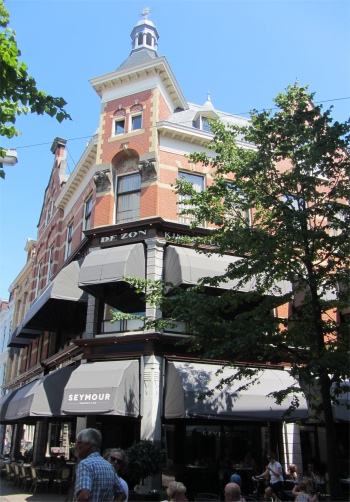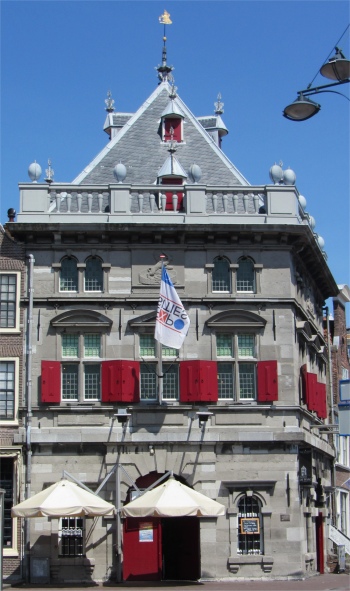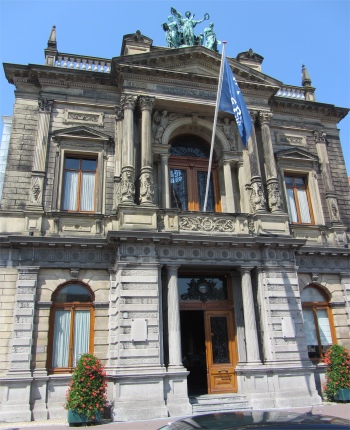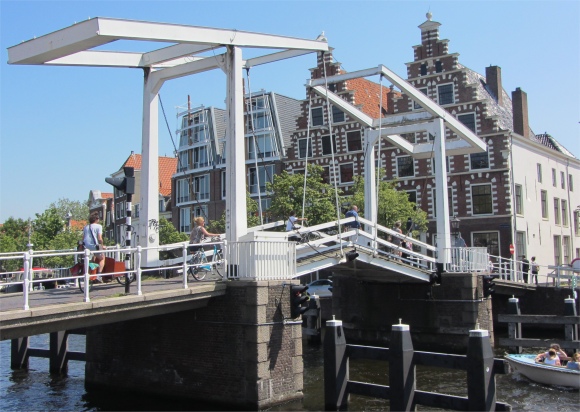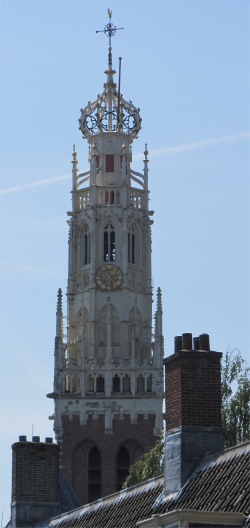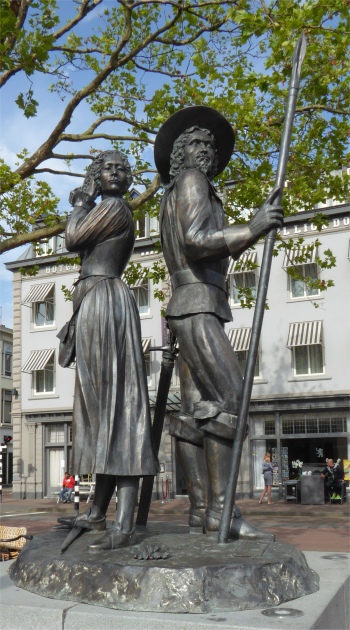 Wigbolt Ripperda and Kenau Simonsdochter Hasselaer |
The small number 14 bus rounded the corner, and Rex handled buying the tickets in Dutch without a problem. His accent was now impeccable. We rattled down the suburbs, at times running alongside the Saarne that we had sailed down less than 24 hours earlier. Down more side streets and there we there, at the bus station just opposite the train station.
In the Stationsplein, shared by the train and bus stations, stood a monument dedicated to Wigbolt Ripperda and Kenau Simonsdochter Hasselaer. During the siege of Haarlem by Spanish troops from 11th December 1572 to 12th July 1573 the city resisted heroically for months. Captain Wigbolt (1535-1573), Baron Wigbolt Ripperda of Winsum in full, was appointed military commander by Prince William of Orange and led the defence of the city. Kenau Simonsdochter Hasselaer (1526-1588), shipbuilder and timber merchant by profession, was ascribed the important role of leader of a regiment of women in defence of the city. Without further ado, we located where the tourist information office was and made a bee line for it.
The office was inside the Stadhuis in the Grote Markt. Like all workers in the Dutch tourist information service, the chap we spoke to spoke excellent English, and he was extremely helpful and friendly. In no time at all we were laden with a map and a tourist trail walking guide.
 Stadhuis |
Haarlem's history begins in Roman times, as a settlement along a through road to Velsen, a Roman garrison town. In the 10th century, a wooden Church of Our Lady and large stone house of the Count of Holland were built in Grote Markt square. The settlement continued to grow around this centre. In 1245, Count Willem II (William II) of Holland granted privileges to Haarlem. From then on, Haarlem became one of the most important cities in Holland. In the Early Modern Period, Haarlem developed itself industrially as a textile city, brewing city, and culturally as a city of painters. In addition, Haarlem was also known for shipbuilding.
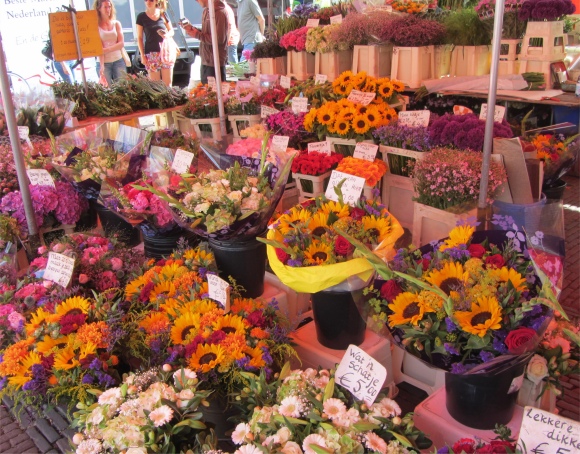 Flowers in the Grote Markt |
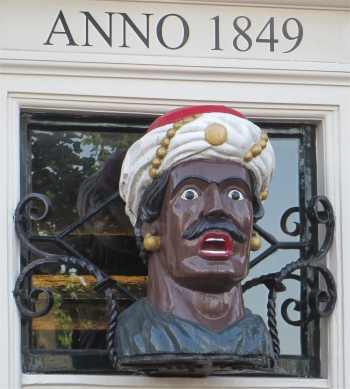 The "Gaper" above Van der Pigge |
Although Haarlem was already being overshadowed economically in the Golden Age by big brother Amsterdam, it continued to be a favoured place to live and stay for the rich and powerful. Both Lodewijk Napoleon (Louis Napoléon Bonaparte) and Princess Wilhelmina, mother of King Willem I (King William I), took up residence at Paviljoen Welgelegen (Pavilion Welgelegen), the current provincial government building.
 Inside Drogisterij A. J. van der Pigge |
The hunting lodge of the Counts of Holland originally stood on the spot where the Stadhuis now stands. Count Floris V lived in the hunting lodge whenever he came to Haarlem to collect his taxes. His son William II preferred to live in The Hague and donated the remains of the lodge to the city.
The wooden building was almost entirely destroyed by fire in the city in the 14th century. When the complex was rebuilt, it was used as the city hall. The current building dates from that period, with the famous Gravenzaal (Hall of Counts) now used as a wedding room. During that same period, the courthouse called the Vierschaar was built, recognised by the four columns on the right facade of the building. In front of the Vierschaar was the scaffold on which justice was administered.
 Leafy Side Streets |
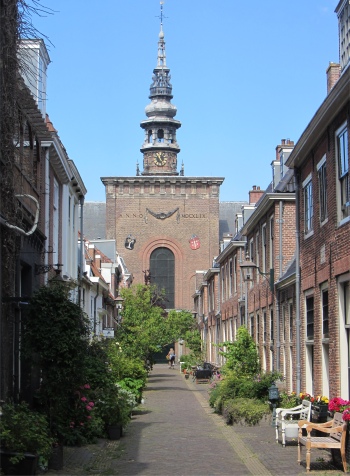 Nieuwe Kerk |
Turning off the busy main street, we walked down a mixture of quiet alleys full of houses boasting much stained glass, lanes almost like gardens. Our detour brought us to the Nieuwe Kerksplein, a square on which the first newly built Protestant church in Haarlem stood, the Nieuwe Kerk. The distinctive feature of this church was the striking Renaissance-style steeple, built between 1613 and 1616 by the Flemish city architect Lieven de Key. The church stood on the former location of the St. Anna cloister. The steeple was built against the former Anna Chapel, which made way for the church in 1645. The church, designed by Jacob van Campen, and the steeple form a peculiar combination of two entirely different architectural styles.
Near the Nieuwe Kerk we managed to gain access into Proveniershof, one of the gardens of the many alms houses in Haarlem. Most of them were closed today - it was Saturday.
Crossing the Grote Houtbrug which spanned the Raamsingel/Gasthuissingel Canal, we strolled down the Houtplein, passing a couple of tempting Indian restaurants. Crumbs, it had been ages since I last had an Indian meal; I was suffering from withdrawal symptoms.
The Houtplein became the Dreef, a wide avenue lined with trees on both sides skirting the Frederikspark, and buzzing with hordes of cyclists. Towards the end of this avenue, on the left, stood a long, red-bricked, imposing building, the Provinciehuis (current County Hall). Around the corner to the left was the front of the Provinciehuis, formerly the Pavilioen Welgelegen. This pavilion was built at the end of the 18th century by Henri Hope, a prominent banker from Amsterdam. The house in neoclassical style served primarily as a storage place for his valuable collection of paintings and antiques. In 1808, Louis Napoleon purchased the Welgelegen Pavilion, which is why so many people know it as his palace. After the period of French rule Queen Wilhelmina lived here, and since 1930 the pavilion has been the home of the Noord-Holland provincial council. To the south of the pavilion the city park, the Haarlemmerhout, lay. The woodland, which is centuries old, was redesigned in 1830 in the English country style by Haarlem landscape architect Zocher.





